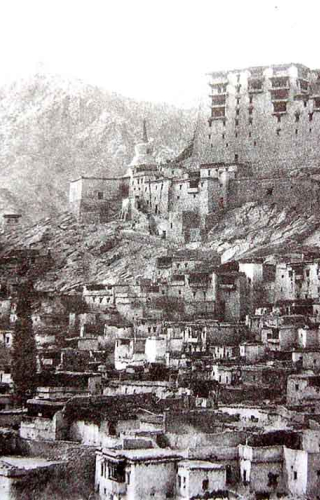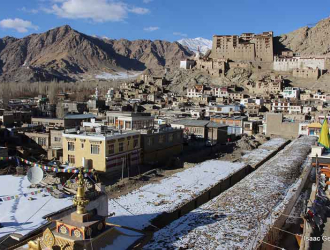The Old Town of Leh, locally referred to as Kharyog, bears testimony to the architectural and socio-cultural history of Ladakh. Historians are not certain when it was first established, but many agree that a small settlement existed much before the Leh Palace was constructed in the first part of the seventeenth century. An early settlement is said to have existed in Chubi, behind the palace; and by the fifteenth century, the fort perched on the hill overlooking the palace had already been built.
The palace and its royal residents gave the town prominence and it grew as a prosperous cultural and trading destination. Large houses came up below the palace along the south-facing hill where their owners were bestowed land by a royal decree, living there by virtue of their association with the king. Below this settlement developed several important spaces—areas for commercial activity such as the Main Bazaar street, Nowshar and Maney Khang; administrative centres such as Basti Ram’s Haveli; and places of worship such as the Maitreya temples and Jama Masjid. Connected by a labyrinth of narrow, winding pathways, the area was surrounded by a wall with five gates.
And to this town came several explorers, scholars, government administrators and missionaries. With greater ease of travel towards the end of the nineteenth century in the Himalayas, they produced much of the early visual imagery of Ladakh and Leh, in particular. By the first part of the twentieth century, photography was much more common and visual records of Leh started to become much richer. By the 1950s, Leh was also home to three photo studios: Syed Ali Shah, Dijoo and Lalit Photo Studio. These three studios were known for their photographic portraits as well as their pictorial coverage of important events and personalities in Ladakh’s history. Together, they formed an important local grouping that established photography in the region and has since inspired future generations of young Ladakhi photographers.
Together, these images form part of important visual documentation of the history of Leh that speaks of its landscape, culture and the people who inhabited the place. They also speak of the changes that have taken place in the town, what has remained and what has been lost. The images in this photoessay look at early images of Leh, those taken before 1947, and juxtapose them with more recent images in an attempt to illustrate the transformations in the town.
















